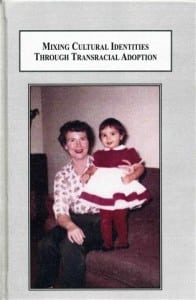 Mixing Cultural Identities Through Transracial Adoption: Outcomes of the Indian Adoption Project (1958-1967). Published 2008 by Edwin Mellen Press. All Rights Reserved.
Mixing Cultural Identities Through Transracial Adoption: Outcomes of the Indian Adoption Project (1958-1967). Published 2008 by Edwin Mellen Press. All Rights Reserved.
On the surface, social memory as a location-maintenance technique appears to be working, mainly because American Indians have been forgotten. Remember the Indian Adoption Project’s objective – to save the “forgotten” Indian child? Indians have been forgotten because they have been made to become invisible, through isolation on reservations or presentations of social ills such as being alcoholics and drunks, a comment made by both adoptees and non-Native participants. This perception was structured to guide a specific outcome: undermine ideas that Natives were capable of self-rule. Incapability is recalled and institutionalized through the media, scientific literature, etc. If Indians can be perceived as drunks because of a genetic flaw, then the nation can put on a Band Aid and move on to the next hapless customer, disregarding the imposed isolation, poverty, lack of economic skills and the tragedies of severed families filled with shame at their seeming incompetence. The out-of-sight-out-of-mind, can’t-pull-yourself-up-by-your-bootstraps social group, located near the bottom of the [social] hierarchy, quickly becomes a non-entity. The fact that both non-Indians as well as Indian transracial adoptees named “Indians as drunks” is indicative of the power to maintain the status quo within the hierarchy.
If Indians have been remembered at all, it is static and unchanging, an image, photographic in nature, of “extinct” gloriously bonneted warriors who freely roamed the land now known as the United States of America. But how do Indians become forgotten? By becoming invisible. Still today, schools rarely present any information of Indians in contemporary life, but rather quickly inventory attitudes and actions in the 19th century without requiring an understanding of why these conflicts occurred or what issues their resistance really addressed…
Another institution of social memory is established through remembered figures of heroes and heroines, concepts that American Indian adoptees grew up hearing frequently, as these mythic figures were visited and revisited through stories and history books. American Indian heroes and heroines provide signals that remind groups “of their place” in the social space. For instance, Pocahontas is remembered for welcoming the colonizers; Sacagawea is remembered for her guiding assistance to Lewis and Clark in the “opening of the west”; Chief Joseph is remembered more for his “I will fight no more forever” speech rather than for his skill of resistance. Even Sitting Bull’s portrayal as a sell-out by joining Buffalo Bill Cody’s Wild West Show has been circulated and re-circulated, diluting the once powerful images of Indian leadership…
American Indian transracial adoptees on vacation with their adoptive families become aware that their assigned social position is very often different from their adoptive families, as historical markers illuminate and underline these differences. The Custer Battlefield was forced to change its name because no respectable battlefield is named after the defeated enemy. Unfortunately, the name change reflected the battle’s geographical location – the Little Bighorn Battlefield. The winners, the Sioux, Cheyenne and Arapaho warriors, remain conspicuously absent from America’s memory. Another example of social memory, evident for all to see, is found on the historical information sign erected by the Bureau of Land Management. Its placement on the Pony Express Trail in Utah describes the “plagues of Indians” that made construction of this route difficult in the late 1800s. “Plague” connotes a dangerous unseen body that requires extermination. These examples provide the lens with which American Indians in this country are to be viewed. Nomenclatures and historical markers are reminders that reinforce, shape and inform the day-to-day interactions between American Indians and Euro-Americans reminding Indians of their status, no matter how much they have achieved …